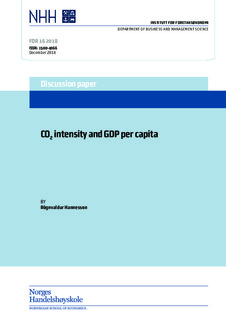| dc.description.abstract | The relationship between CO2 intensity and GDP per capita is studied. Most rich countries show falling CO2 intensity over time and a negative correlation with GDP per capita. Many poor and medium rich countries show the opposite, a positive time trend and a positive correlation with GDP per capita. For the majority of countries with a negative correlation between CO2 intensity and GDP per capita a non-linear function fits the data better than a linear one, implying that CO2 intensity falls at a diminishing rate as countries get richer. Hence, economic growth will not by itself go very far in reconciling economic growth and reductions in CO2 emissions. There are indications that poor and medium rich countries experience a boost in CO2 intensity as they embark on industrialization. This will also make it harder to reconcile economic growth and cuts in CO2 emissions. | nb_NO |
